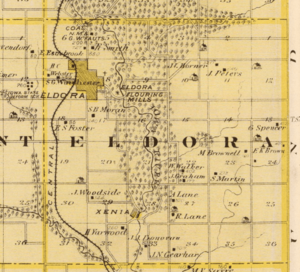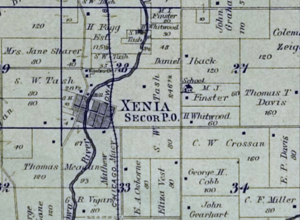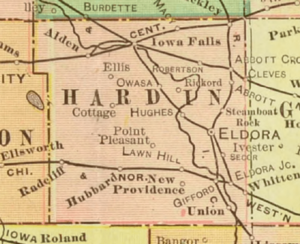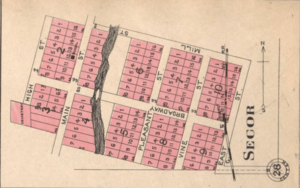Secor, Iowa facts for kids
Quick facts for kids
Secor, Iowa
Xenia, Iowa or Delanti, Iowa
|
|
|---|---|
| Country | United States |
| State | Iowa |
| County | Hardin |
| Elevation | 968 ft (295 m) |
| Time zone | UTC-6 (Central (CST)) |
| • Summer (DST) | UTC-5 (CDT) |
| Area code(s) | 641 |
| GNIS feature ID | 465437 |
Secor is a ghost town in Hardin County, Iowa, United States. A ghost town is a place where most people have left, and very few or no one lives there anymore. Secor was also known by two other names: Xenia and Delanti.
This community was about 3.5 miles (5.6 km) south-southeast of Eldora. Long ago, it was important because it had one of the only bridges over the Iowa River in Hardin County. But by the mid-1900s, Secor had lost its school, mill, post office, and businesses. That's why it became known as a ghost town. A newspaper article from 1955 even called it "a place with three different names."
Contents
Where is Secor Located?
Secor is located at coordinates 42°18′40″N 93°04′51″W. It sits along the South Fork of the Iowa River.
The Story of Secor's Names
Secor has a fascinating history because it changed its name two times! Let's explore how this happened.
Xenia: The First Name
Around 1853, a bridge was built across the Iowa River at this spot. For a while, it was the only bridge in Hardin County. People said the bridge was a bit shaky, so it was made stronger in 1866.
The village was first called Xenia. It was officially planned out in 1857. The original part of the town was on the southwest side of Section 28 in Eldora Township.
In its early days, Xenia was a busy little village. It had a general store, a blacksmith shop, a wagon shop, and a good mill. There were also about 15 to 20 houses.
Delanti: The Second Name
In 1858, the post office in Xenia changed its name to Delanti. This post office stayed open until 1870. Around 1865, about 100 people lived in Delanti.
The community had three churches: Methodist, Baptist, and Christian. Many stagecoaches used the bridge to pass through Delanti. Sometimes, the name was also spelled Delanta.
By the 1880s, the town started to shrink. There were only about a dozen homes and the mill left.
Secor: The Final Name
The community's name was changed again, this time to Secor. The old Xenia town plan was officially canceled. The Chicago and North Western Railroad built a train station in Secor.
A new post office opened in Secor in 1883. The town's new plan was set up in 1888. It was named after a railroad worker named Secor, but sources disagree on which person it honored. Some say it was named after Eugene Secor, while others say it was for Davide Secor, who helped pay for part of the railroad line.
Secor's town plan had ten blocks. The school was on the west side of the river, and the train tracks were on the east side. The streets running north-south were called High Street, Main Street, Pleasant Street, Vine Street, and East Street. The streets running east-west were Broadway Street and Mill Street.
In 1890, Secor had 32 people living there. The Secor post office closed in 1900. Around 1912, the old Xenia mill, one of the first buildings in the area, was torn down.
Secor had its own school district, which had five teachers in 1911. This school district was still called the Xenia Independent School District.
In 1911, the steel Secor Bridge across the Iowa River collapsed while it was being repaired. No one died, but some workers were hurt. A new bridge, 140 feet (43 m) long, was built to replace it for $3,434.
Why Secor Became a Ghost Town
Even with a railroad, Secor didn't grow much. The name change didn't bring many new people. In 1921, the Xenia and Secor schoolhouses were sold. This happened when the school district joined the Eldora School District. The Xenia Schoolhouse sold for $110, and the Secor Schoolhouse sold for $250.
By 1940, Secor's population was only 60 people. By the late 1940s, Secor was officially considered a ghost town. Today, it remains a ghost town, with only a few farms in the area.
Some maps show the local cemetery as Xenia-Secor Cemetery.







